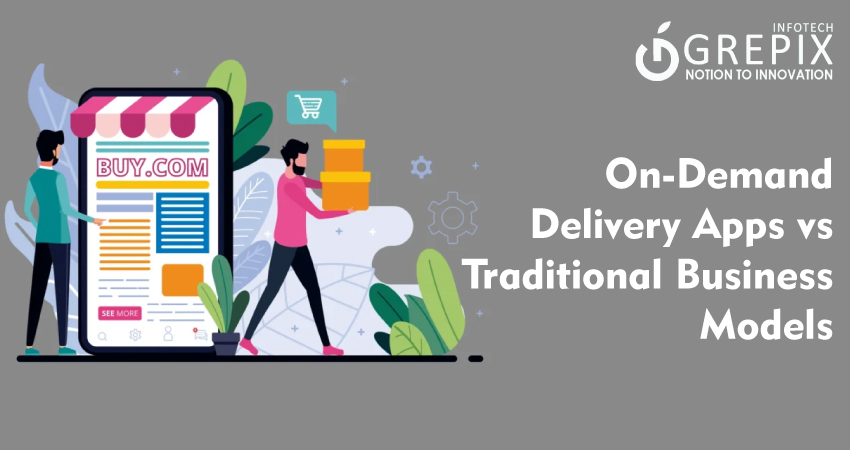On-Demand Delivery Apps vs Traditional Business Models
The way businesses deliver products and services has changed dramatically in the last decade. The rise of the on demand delivery app has created a digital marketplace where convenience and immediacy dominate. These apps allow customers to order food, groceries, handyman services, and even transportation with a few taps. Companies like Uber, Urban Company, and Porter have set the benchmark for this growing sector.
On the other hand, traditional business models based on brick-and-mortar stores, manual delivery systems, and personal interactions still hold relevance, especially for loyal customer bases and local markets.
This blog explores the clash between these two models, their advantages, drawbacks, and the future of the industry, focusing on on demand app development, home services apps, and the rising trend of clone app solutions like the UrbanClap Clone App and Porter Clone.
The rise of on demand delivery apps has transformed how businesses and consumers interact, creating instant service models that challenge traditional business frameworks. While traditional retail and delivery methods rely on physical presence and in-store operations, on demand applications leverage technology for scalable, real-time service. This article compares both models in terms of customer experience, operational efficiency, costs, scalability, and long-term sustainability. We also explore the role of technology, AI, and hybrid models in shaping the future of business. Entrepreneurs will gain insights into which approach suits their growth strategy in today's fast-changing market.
Market Landscape
Growth of the On-Demand Economy
The on-demand economy is growing at an exponential rate. According to recent studies, the global gig and on-demand services market is expected to surpass $1.57 trillion by 2027. Apps like on demand home services apps and on demand handyman apps are being embraced widely because they solve consumer pain-points instantly. Convenience, transparency, and speed are the driving factors.
Persistence of Traditional Models
Despite the rise of digital, traditional delivery and retail models still thrive, particularly in smaller towns and for demographics with lower digital access. Physical presence ensures credibility, trust, and personal relationships as anchors of loyalty.
Changing Consumer Expectations
Modern consumers expect instant gratification, digital payment options, and real-time order tracking. This is pushing traditional businesses to either digitize operations or risk losing market share to companies powered by on-demand app development companies.
Customer Experience
On-Demand Apps
- Real-time tracking of orders and services.
- Wide range of vendors and service providers under a single platform.
- Instant payment options, digital wallets, and simplified checkout.
Example: The Urban Company Clone provides quick handyman services at your doorstep, improving reliability.
Traditional Models
- Customers must physically visit stores or make calls to schedule services.
- Delivery windows are less flexible and often slower.
- Limited payment modes, usually cash-heavy.
- Personalized interaction with staff can help build long-term loyalty.
Takeaway: On-demand applications enhance convenience, while traditional models prioritize physical relationships.
Operational Efficiency
On-Demand Delivery Apps
- Automated dispatch systems reduce human error.
- GPS-based route optimization lowers fuel costs and delivery time.
- Digital payment systems streamline the transaction process.
Platforms like the Porter Clone improve logistics efficiency.
Traditional Models
- Manual dispatch and scheduling waste time and increase delays.
- Limited delivery fleets or resources create inefficiencies.
- Handling cash creates risks of fraud and reconciliation issues.
Takeaway: On-demand platforms leverage tech to scale smoothly, while traditional methods strain resources.
Cost Structures
On-Demand Apps
- Require upfront investment in technology from an on demand app development company.
- Ongoing costs include server maintenance, customer acquisition, and commissions to service providers.
- Flexible monetization through subscription models, commissions, and advertisements.
Understanding on demand delivery app development cost is crucial before launching.
Traditional Models
- Costs are heavily tied to rental spaces, staffing, and utilities.
- To expand, businesses must set up physical outlets, which is capital intensive.
- Lower technology costs but higher recurring overheads.
Takeaway: On-demand applications need higher tech investment but offer long-term scalability with relatively lower overhead.
Scalability and Reach
On-Demand Apps
- Cloud-based infrastructure enables expansion across geographies.
- The UrbanClap Clone App or Urban Company Clone can launch in multiple cities with slight tweaks.
- Digital marketing makes customer acquisition faster and efficient.
Traditional Models
- Expansion requires setting up new stores in each geography.
- Scale-up is slow due to real-estate, licensing, and staff hiring.
- Geographic reach remains limited to physical presence.
Takeaway: On-demand apps scale rapidly, while traditional models expand at a slower pace.
Also Read: "Why On-Demand Healthcare Apps Are Skyrocketing in 2025"
Business Risks and Challenges
On-Demand Apps
- Dependence on stable technology and internet access.
- Intense competition among multiple clone apps and startups.
- Regulatory challenges around taxation, labor laws, and compliance.
Traditional Models
- Decline of walk-in customers due to changing consumer behavior.
- High fixed costs make profitability harder when demand dips.
- Struggle to adapt quickly to market shifts.
Future Outlook
- Hybrid Models: Many businesses are moving toward a mix of online + offline presence to capture both demographics.
- AI & Automation: Route optimization, chatbots for customer support, and predictive inventory planning.
- Logistics Tech: Partnerships with Porter Clones and other logistics platforms to fast-track fulfillment.
- Consumer Shifts: Younger generations prefer digital-first solutions like on demand home services apps over traditional setups.
Conclusion
Both on demand delivery apps and traditional business models have unique strengths and challenges. On-demand apps excel in customer experience, operational efficiency, and scalability, while traditional businesses provide trust and human interaction.
For entrepreneurs, the key lies in understanding target customers and investment capabilities. If the priority is scalability and speed, investing in an on demand application built by an experienced on demand app development company is the right choice. However, businesses rooted in local presence may still gain from hybrid approaches.
Final Call-to-Action: If you are planning to enter the on-demand space, consider building your platform with affordable solutions like an Urban Company Clone, UrbanClap Clone App, or Porter Clone. Understanding the on demand delivery app development cost upfront will help you make smarter investment decisions and scale faster in this competitive market.
FAQs
1. What is the cost of on demand delivery app development?
The on demand delivery app development cost depends on features, platform (iOS, Android, or both), integrations, and customization needs. On average, costs can range from $25,000 to $75,000.
2. Which industries benefit most from on demand applications?
Industries like home services, logistics, food delivery, transportation, and e-commerce benefit the most from on demand applications.
3. Are clone apps like UrbanClap Clone App effective?
Yes, clone apps like UrbanClap Clone App or Porter Clone reduce time-to-market and development cost, making them highly effective for startups.
4. Why should businesses invest in on demand handyman apps?
On demand handyman apps simplify booking services, increase customer retention, and create new revenue streams for businesses in the repair and maintenance sector.
5. Can traditional businesses compete with on demand models?
Yes, but success often requires adopting hybrid models—combining offline trust with on-demand digital operations.







